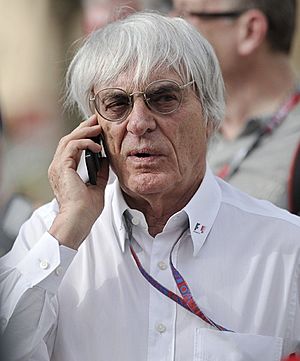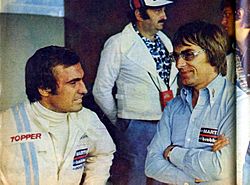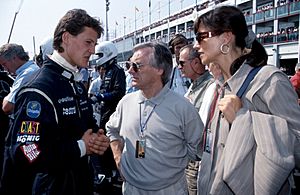Bernie Ecclestone facts for kids
Quick facts for kids
Bernie Ecclestone
|
|
|---|---|

Ecclestone at the 2012 Bahrain Grand Prix
|
|
| Born |
Bernard Charles Ecclestone
28 October 1930 St Peter South Elmham, Suffolk, England
|
| Occupation |
|
| Years active | 1950–present |
| Known for | Founder and CEO of the Formula One Group (1987–2017) |
| Spouse(s) |
Ivy Bamford
(m. 1952; div. 1967)Slavica Radić
(m. 1985; div. 2009)Fabiana Flosi
(m. 2012) |
| Children | 4, including Tamara and Petra |
| Formula One World Championship career | |
| Nationality | |
| Active years | 1958 |
| Teams | Privateer Connaught |
| Entries | 2 (0 starts) |
| Championships | 0 |
| Wins | 0 |
| Podiums | 0 |
| Career points | 0 |
| Pole positions | 0 |
| Fastest laps | 0 |
| First entry | 1958 Monaco Grand Prix |
| Last entry | 1958 British Grand Prix |
Bernard Charles Ecclestone (born 28 October 1930) is a British businessman, a leader in car racing, and a former race car driver. He is widely known as the "F1 Supremo". Ecclestone started the Formula One Group in 1987. He managed the business side of Formula One until 2017.
Born in Suffolk and raised in Bexleyheath, Ecclestone began his career selling motorcycle parts after World War II. He started racing in Formula Three in 1949. He won several races at Brands Hatch driving a Cooper Mk V. In 1958, Ecclestone tried to race in Formula One at the Monaco and British Grands Prix, but he did not qualify.
He later became a manager for drivers like Stuart Lewis-Evans and Jochen Rindt. Rindt won the World Drivers' Championship in 1970 after he had passed away. Ecclestone bought the Brabham racing team in 1972 and ran it for 15 years. Under his leadership, Brabham won 22 races and two World Drivers' Championship titles with Nelson Piquet.
Ecclestone also helped create the Formula One Constructors' Association (FOCA) in 1974. He played a big part in selling television rights for Formula One races. This helped the sport grow a lot. He also managed the setup and planning for each Formula One Grand Prix. In 2017, he sold the Formula One Group to Liberty Media. He then served as an advisor until 2020.
Contents
Early Life and Education
Ecclestone was born on 28 October 1930 in St Peter South Elmham, a small village in Suffolk. His father, Sidney Ecclestone, was a fisherman. His mother was Bertha Sophia.
The family moved to Bexleyheath, London, in 1938. Bernie attended primary school in Wissett, Suffolk. He stayed with his family in London during World War II.
Ecclestone left school at 16. He worked as an assistant in a chemical lab, checking gas purity. He also studied chemistry at Woolwich Polytechnic. During this time, he continued his hobby of working with motorcycles.
Motorsports Journey
Starting in Racing
After World War II, Ecclestone started a business selling spare parts for motorcycles. He also opened a motorcycle dealership called Compton & Ecclestone. His first experience in racing was in 1949 in the 500cc Formula 3 Series. He bought a Cooper Mk V in 1951.
He raced in a limited number of events, mostly at his local track, Brands Hatch. He achieved good results and even won some races. He stopped racing for a while after a few accidents at Brands Hatch. He wanted to focus on his growing businesses.
Leading a Racing Team
After his racing break, Ecclestone made smart investments in property and loans. He also managed a car auction company. He returned to racing in 1957 as a manager for driver Stuart Lewis-Evans. He also bought two cars from the Connaught Formula One team, which had closed down.
Ecclestone even tried to qualify a car himself at Monaco in 1958, but he didn't make it. He continued to manage Lewis-Evans, who later moved to the Vanwall team. Sadly, Lewis-Evans was badly hurt in a crash in 1958 and passed away. This event deeply affected Ecclestone, and he stepped away from racing again.
His friendship with driver Roy Salvadori led him to manage another driver, Jochen Rindt. Ecclestone also became a part-owner of Rindt's Lotus Formula 2 team in 1970. Rindt won the 1970 World Championship, even though he passed away in a crash during that season.
Taking Over Brabham
In 1971, Ron Tauranac, who owned the Brabham team, looked for a business partner. Ecclestone offered him £100,000 for the entire team, and Tauranac accepted. Tauranac stayed on to design cars and run the factory for a short time.
Ecclestone wanted to change the team. He stopped the business of selling customer cars, which Brabham had been known for. He believed that to win in Formula One, all efforts should be focused on the main racing team. For the 1973 season, Ecclestone made Gordon Murray the chief designer. Murray created successful cars that helped Brabham win races in 1974 and 1975 with drivers Carlos Reutemann and Carlos Pace.

Even with the success of their Ford-powered cars, Ecclestone made a deal with Alfa Romeo in 1976. They would use Alfa Romeo's powerful but heavy engines. This deal was good financially, but the new cars were not very reliable and were too heavy. Brabham struggled in 1976 and 1977.
In 1978, Ecclestone signed the Austrian world champion Niki Lauda. Brabham won two races that year. The partnership with Alfa Romeo ended in 1979. Ecclestone then decided to use Cosworth DFV engines again.
Nelson Piquet joined the team and became very close to Ecclestone. Piquet won the championship in 1981 and 1983. In 1981, Brabham tested a car with a BMW turbo engine. The 1982 car, the BT50, used BMW's turbocharged engine. This partnership led to the first turbo-powered world championship in 1983.
The team remained competitive until 1985. Piquet left after seven years, moving to Williams. The next year, Gordon Murray, who had designed many winning cars, also left Brabham. Brabham continued under Ecclestone's leadership until the end of the 1987 season. BMW also left Formula One after that season.
Ecclestone had bought the team for about $120,000 in 1971. He later sold it for over $5 million to a Swiss businessman in 1988.
Becoming a Formula One Leader

While owning the Brabham team, Ecclestone also helped create the Formula One Constructors Association (FOCA) in 1974. He worked with other team owners like Frank Williams and Max Mosley. He became more involved in FOCA, especially in getting television rights for the sport.
Ecclestone became the chief executive of FOCA in 1978. With Max Mosley as his legal advisor, they worked through many legal challenges. Ecclestone successfully gained the right for FOCA to negotiate TV deals for the Grand Prix races. He set up Formula One Promotions and Administration (FOPA) for this purpose. This arrangement gave 47% of TV money to the teams, 30% to the FIA (the sport's governing body), and 23% to FOPA. In return, FOPA provided the prize money for the races.
Television rights changed hands among Ecclestone's companies, teams, and the FIA in the late 1990s. But Ecclestone remained in control. In 1997, he negotiated the fourth Concorde Agreement. This deal allowed him to keep the television rights in exchange for yearly payments. Ecclestone and his companies also managed the organization, setup, and planning of each Grand Prix.
In 1978, Ecclestone hired Sid Watkins as the official Formula One medical doctor. After a crash at the 1978 Italian Grand Prix, Watkins asked Ecclestone for better safety measures. These improvements were put in place for the next race. This was the start of major safety improvements in Formula One, which greatly reduced serious injuries and deaths over the years.
In 1999, Ecclestone had heart surgery. Despite this, he remained very active in promoting his business interests. In the late 1990s, he reduced his share in SLEC Holdings (the company that owned the F1 managing firms) to 25%. Even with a smaller share, he kept full control of the companies.
In October 2004, Ecclestone faced criticism when the British Grand Prix was almost removed from the 2005 calendar. This was because he and the British Racing Drivers' Club could not agree on terms. However, a contract was signed in December 2004 to keep the race for five more years.
In November 2004, three banks that owned a large share of Formula One sued Ecclestone. They wanted more control over the sport. This led to talk that Ecclestone might lose his control, which he had held for over 30 years. A judge ruled in favor of the banks in December 2004. However, Ecclestone said the ruling would mean "nothing at all" and planned to appeal.
In 2005, 14 out of 20 cars pulled out of the 2005 United States Grand Prix at the Indianapolis Motor Speedway. The teams refused to race due to concerns about their Michelin tires. They wanted rule changes or a different track setup. Despite many meetings, no solution was found before the race. This resulted in only six cars racing. Fans and journalists were upset and blamed Ecclestone for not taking control and finding a solution.
On 25 November 2005, CVC Capital Partners announced they would buy Ecclestone's shares in the Formula One Group. They also bought shares from one of the banks. This gave CVC a large ownership of Formula One. Ecclestone used the money from this sale to buy a share in the new company.
Ecclestone was removed from his role as chief executive of the Formula One Group on 23 January 2017. This happened after Liberty Media took over the company in 2016. He was given an honorary role as an advisor until his term ended in January 2020.
Other Business Ventures
In 1996, Ecclestone's company, International Sportsworld Communicators, signed a long-term deal with the FIA. This gave them exclusive broadcasting rights for 18 FIA championships. In 1999, the European Commission looked into this deal. As a result, in 2000, ISC and FIA made a new agreement. Ecclestone later sold ISC to a group led by David Richards.
On 7 January 2010, it was announced that Ecclestone, along with Genii Capital, had made an offer to buy the Swedish car brand Saab Automobile.
Queens Park Rangers Football Club
On 3 September 2007, it was announced that Ecclestone and Flavio Briatore had bought Queens Park Rangers (QPR) Football Club. In December 2007, businessman Lakshmi Mittal, one of the richest people in the world, joined them as a co-owner. He bought 20% of the club.
On 17 December 2010, Ecclestone bought most of Flavio Briatore's shares. This made him the main shareholder with 62% of the shares. On 18 August 2011, Ecclestone and Briatore sold all their shares in the club to Tony Fernandes. Fernandes is known for owning the Caterham Formula 1 team.
Ecclestone's Car Collection
Ecclestone owned a very large collection of Formula One cars. His collection of 69 single-seater cars was one of the biggest racing car collections in the world. It included historic cars like the Ferrari 375 F1 and the Brabham BT46B. This entire collection was later sold to Mark Mateschitz, an heir of Red Bull GmbH.
Personal Life
As of February 2024, Forbes estimated Ecclestone's wealth to be around $2.9 billion. In 2002, he was listed as the fifth-richest person in the United Kingdom. In 2004, he sold one of his London homes for £57.1 million. At Grand Prix events, Ecclestone used a grey mobile home, known as "Bernie's bus," as his office. In 2005, he sold his yacht Va Bene to his friend Eric Clapton. Ecclestone turned down a special honor from the Queen in 1996 and a knighthood later. He said he didn't feel he deserved them.
Ecclestone has been married three times. With his first wife, Ivy, he has a daughter named Deborah. Through Deborah, he is a great-grandfather. He has five grandchildren. Ecclestone had a long relationship with Tuana Tan, which ended in 1984. He then married Slavica Radić, a former model, and they were married for 23 years. They have two daughters, Tamara (born 1984) and Petra (born 1988). They separated in 2008, and their divorce was finalized in 2009. In August 2012, Ecclestone married Fabiana Flosi, who was the vice-president of marketing for the Brazilian Grand Prix. Flosi is 46 years younger than Ecclestone. Their son was born in July 2020.
Complete Formula One World Championship Results
(key)
| Year | Entrant | Chassis | Engine | 1 | 2 | 3 | 4 | 5 | 6 | 7 | 8 | 9 | 10 | 11 | WDC | Points |
|---|---|---|---|---|---|---|---|---|---|---|---|---|---|---|---|---|
| 1958 | B C Ecclestone | Connaught Type B | Alta Straight-4 | ARG | MON DNQ |
NED | 500 | BEL | FRA | GBR DNP |
GER | POR | ITA | MOR | NC | 0 |
|
|
||||||||||||||||
Awards and Honors
Special Awards
Honorary Degrees
Other Recognitions
- FIA President Innovation Medal: 2024
- Autosport Awards 75th Anniversary Honouree Prize: 2024
See also
 In Spanish: Bernie Ecclestone para niños
In Spanish: Bernie Ecclestone para niños

